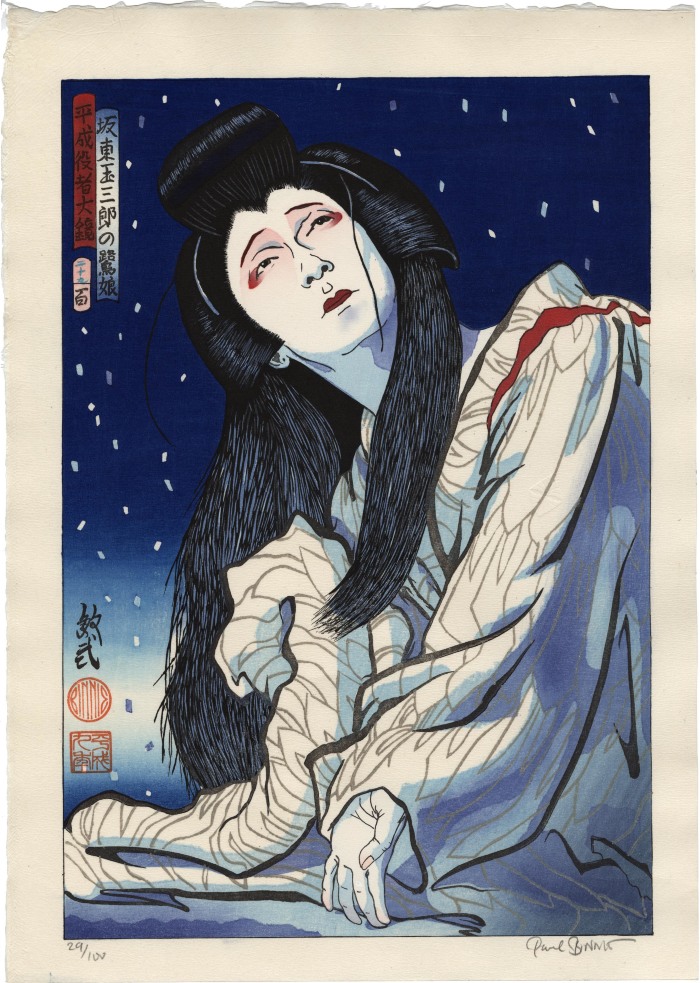Paul Binnie (artist 1967 –)
Bandō Tamasaburō V (坂東玉三郎) as the Spirit of the Heron in The Heron Maiden (Sagi Musume 鷺娘) from the series 'A Great Mirror of the Actors of the Heisei Period' (Heisei Yakusha Okagami - 平成役者大鏡)
05/1997
11.875 in x 17 in (Overall dimensions) Japanese woodblock print
Signed in kanji: Bin-ni (敏弐)
Signed in pencil: Paul Binnie
Artist's seal: Binnie
Date seal: Heisei kyu-nen
Numbered in pencil: 12/100
Series numbered 二十九 (29)
Ritsumeikan - 2007 exhibition entry
The Binnie Catalogue
National Museum of Asian Art In Taishō Chic : Japanese Modernity, Nostalgia, and Deco it says on page 104 it says: "The Heron Maiden or Sagi musume was both a frequent pictorial subject in bijinga of the 1920s and 1930s and the subject of a popular Kabuki play. The dance drama (shosagoto) was originally performed in 1762 at Edo’s Ichimuraza, and it likely derived from old shrine dances as well as from folk tales. In this transformation work (hengemono), a woodcutter saves a white heron and takes it home. Soon afterward, a beautiful young woman — the spirit of the heron — arrives at the impoverished woodcutter’s house. She takes pity on him, and they marry. One night she offers to help him earn some money, then retires to another room with the admonition that he must not look at her. There she transforms herself into a beautiful heron and weaves a cape of white feathers plucked from her own skin. The next day she gives her husband the cape, he sells it and greedily asks her for another garment. Unable to refuse him despite the pain it causes, she makes cape after cape until she has plucked every feather from her body. As she lies bleeding, the woodcutter breaks his promise and enters the room. In the climax, the woodcutter realizes that his greed has nearly killed his beloved, and lie returns the heron to the wild."
"The play was revived as a one-act dance by Ichikawa Danjuro II in 1886, featuring a famous “quick-change” of costume as the heron reverts back to the young woman."
"The themes of transformation, beauty, and sacrifice appealed to female audiences who could likely find parallels in their own dreams, if not in their lives. Wraithlike women were common in Taishō art and popular illustration — particularly in designs by Takehisa Yumeji — so it is not surprising that this poignant tale of a female spirit should have found favor on stage as well as in pictures. As a personification of purity, represented by the whiteness of snow, the Heron Maiden is usually imbued with an almost ethereal elegance."
****
Scholten Japanese Art wrote of this performance:
"Sagi Musume is set beside a frozen pond in the middle of winter as confetti, simulating falling snow and sensitively depicted in the composition in white, grey, and purple, falls onto the stage. The Heron Spirit performs a number of transformations over the course of the dance. In the first section the spirit conjures a young maiden, dressed in a red kimono whose dance reflects the joy of love. However, the transformations are successively more bleak, culminating in the final change, which is depicted in this composition. The maiden lies upon the stage floor, suffering in hell for the frivolity of her youth. She is dressed in white and is depicted with deep sadness upon her face."
On another page Scholten wrote:
"This portrait of Bando Tamasaburo V (b. 1950) depicts the actor, famous for his skills as a dancer, in the poignant role of The Heron Maiden. The scene is near the end of the dance when the maiden suffers in hell for her frivolous youth. The stark, angular flakes in the background, sensitively printed in white, grey and purple, are the confetti used to simulate falling snow."
****
This is from an edition of 100. It was carved and printed by the artist himself.
****
Illustrated in Paul Binnie: A Dialogue with the Past: the First 100 Japanese Prints, edited by E. Van den Ing, 2007, Art Media Resources, Chicago, page 49.
self-printed (sōsaku hanga - 創作版画) (genre)
actor prints (yakusha-e - 役者絵) (genre)
Bandō Tamasaburō V (五代目坂東玉三郎: since June 1964) (actor)
